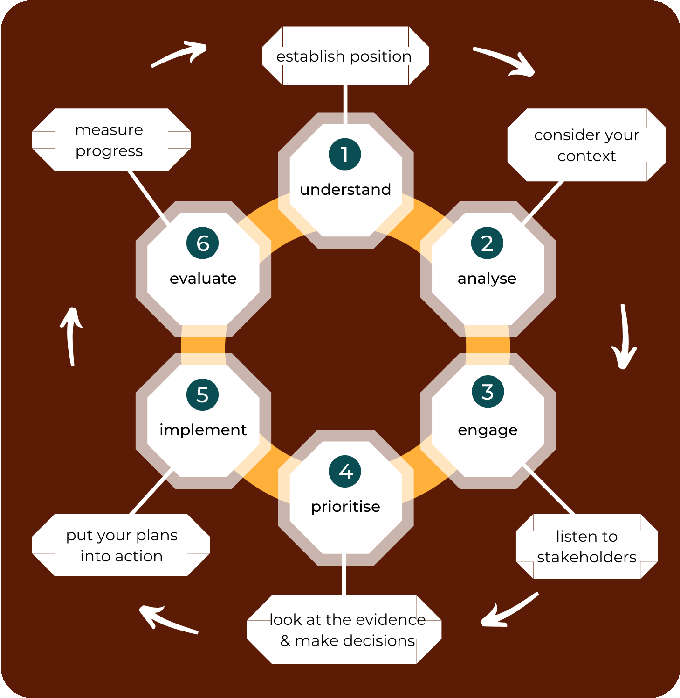
If you’ve ever had the pleasure of reading university strategic plans, you might have been tempted to hang your head in despair! They often sound very similar, have too many – or too few – ways to evaluate progress, and are divorced from what really happens in the institution. In response, we’ve developed an approach that puts people at the heart of strategy development. In this post, we outline the steps involved and share our top tips for creating effective strategy.
What is strategy anyway?
Put simply, a strategy is a long-term plan that will help you go from where you are now to where you want to be. Any organisation or organisational unit – whatever size or shape – needs a strategy to address their challenges and make the most of opportunities. This is true for universities as much as any other complex organisation. Of course, it’s not the strategy document that’s important. It’s the cyclical process of understanding the context, identifying priorities, making decisions, taking action, and evaluating progress that is really valuable.

Understanding and analysis
The first steps in any successful strategy development are to understand and analyse your position. This might sound obvious, but you’d be surprised at how many get tempted to dive straight in to thinking about priorities. Taking stock of where you are now is an essential part of getting to where you want to be. So, start with some honest reflection. Look at the purpose of your university, department, directorate or activity; the external context that informs how you operate; aspects of your performance related to the strategy; and gather different perspectives and insights, through a strategy steering group.
Engagement

‘Stakeholder engagement’ is an overused term, but we find it useful to describe the process of keeping those with an interest in what you do – be they staff, funders, students, community groups, partners, or suppliers – involved in your decision making. Engagement works best if you follow a transparent process. So, while we involve as wide a group of stakeholders as possible, group them by their interest, and develop and deliver a range of resources that will help them to engage, we put a particular focus on considering the feedback. We note down how we’ve responded to it – or why we haven’t – and then share all this with our stakeholders. Why? Because People are much more understanding if they can see that they haven’t been ignored.
Prioritisation

Once you’ve collected all the information, you need to use it to inform your decisions. Strategies call for trade-offs, as doing more of one thing usually means doing less of something else. And this is hard. But being strategic about the trade-offs puts you in the driving seat, helping you to make choices using the evidence you’ve collected. Ask yourselves what you might be able to start doing and, perhaps more importantly, what you can stop doing or do differently. Look forward to where you want to be in three to five years. Then bring it back to your purpose to sense-check your decisions.
Implementation
Where your strategy provides the what and why of activities, your implementation should focus on the who, where, when and how. Start by working out the specific actions you’ll need to deliver your strategy and when in the timeframe these tasks should be completed. Your implementation plan should then capture these actions and plot them against a one, three- or five-year timescale. Don’t forget to assign ‘ownership’ to each of the tasks. This means identifying who is responsible for doing the actions that are needed for each strategy area AND who is accountable for making sure that the change happens.
Evaluation
Finally, you’ll need to measure how successful your strategy has been in moving you from where you started to where you want to be. And although we’ve saved this to the end, this final stage is one that starts near the beginning of the strategy development process and lasts until you develop your next plan. So, as you start your strategy, identify the measures you can use to help in your evaluation, baseline your starting position and define what success will look like. Monitor progress throughout the period of the strategic plan and don’t be afraid to make changes, in the measures you’re using, your projected timescales or the actions you take.

And that’s it in a nutshell! But before we go, here are our top tips for managing successful strategy in a university setting:
1: Time
Effective strategy takes time. You need time to understand the context, identify challenges and opportunities, and share that understanding with colleagues. You need time to discuss options and ambitions and reach agreement on priorities. And you need time to develop detailed action plans. Most of all, you need time to talk to people.
2: Expectations
Having a good strategy doesn’t fix everything. If you have an ineffective culture, or cumbersome business processes, then your strategy isn’t going to be the (only) answer. Strategies set an overall framework for direction. You’ll need specific objectives within them to address the things you need to change.
3: Widen your horizons before narrowing them
Effective strategies are all about prioritisation. But before you narrow down, think as broadly and openly as you can about potential challenges and opportunities. The best strategies come out of this wide horizon scanning, so be creative and keep an open mind.
4: Think beyond the timeline of your strategic plan
Strategic plans tend to be for a set period, commonly building a framework for the next three or five years. But really effective strategies are those that look beyond that. An extended timeframe lets you to see what changes are likely – or possible – and enables you to start planning for them now.
5: Talk to people
If you don’t take anything else away, remember this. Strategies will only be effective if you talk to people. It gives them a sense of ownership and lets you know what they think. Without this, they’ll struggle to care about your strategy, making implementation very tricky. So, get out there and converse.
Dr Jo Edwards, Director
Lucidity Solutions Ltd

Lucidity Solutions Ltd | www.luciditysolutions.co.uk | info@luciditysolutions.co.uk

0 comments on “Lucidity Solutions – Exhibitor Blog”